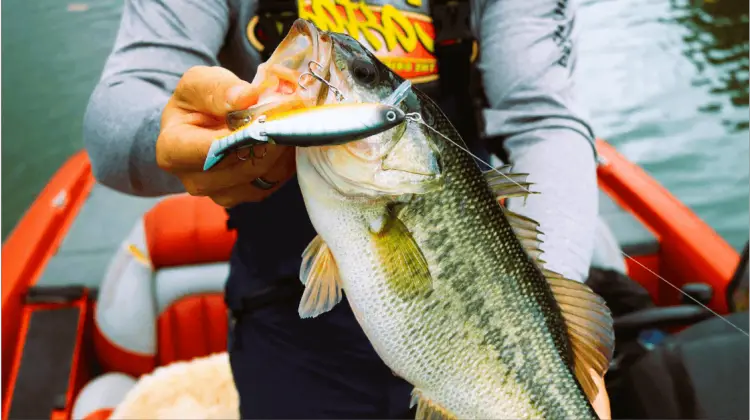
Saltwater topwater lures are exciting for anglers who want an intense fishing experience. They cause big fish to jump out of the water, which excites fishing enthusiasts. These lures look like injured fish on the water, attracting aggressive predators like tarpon, redfish, and striped bass. These lures are eye-catching, and the fish love them.
In addition, these lures are versatile and can be used to catch different fish in different places. They work well in shallow areas and deep waters and can attract fish differently. People who enjoy the excitement of topwater fishing really like using these lures.
What are Saltwater Topwater Lures?
Saltwater topwater lures are a thrilling addition to any angler’s tackle box, offering an exhilarating way to target predatory game fish in the open ocean. Designed to imitate injured baitfish or other surface-dwelling prey, these lures create explosive strikes as they skitter across the water’s surface. With their unique action and enticing splashes, saltwater topwater lures are particularly effective for species such as tuna, dorado, and giant trevally.

Popular Types of Saltwater Topwater Lures
Popper
Regarding saltwater topwater lures, anglers can utilize several different types to attract and hook their target species. One popular type of saltwater topwater lure is the popper. The unique design of a popper creates a loud popping or splashing noise when retrieved, mimicking the sound of prey at the water’s surface and often provoking aggressive strikes from predatory fish.

Sliders Lures
Slider lures are great for saltwater topwater fishing because they work well and attract many types of fish. They look like injured baitfish, which hungry game fish like striped bass, bluefish, and redfish find irresistible.
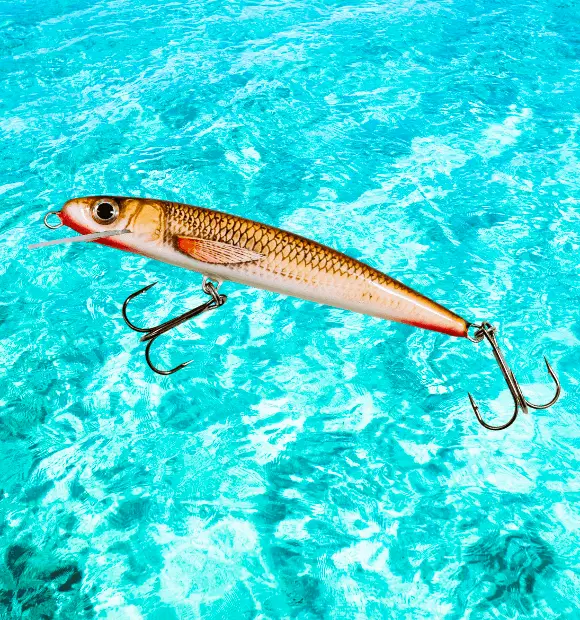
Sliders’ sleek design creates a subtle but attractive movement on the water’s surface, making predators want to strike. Sliders are unique because you can change the hooks, skirts, and colors to match the fishing conditions or target fish. This makes sliders a critical part of any angler’s saltwater tackle box.
Also, sliders can be used at different speeds and rhythms, so anglers can try different ways of using them until they find the best one for the day. Slider lures are known for getting significant strikes from saltwater predators, so they’re a must-have for any topwater angler who wants to improve their game in the ocean or coastal waters.
Floating Jerk Baits
Floating jerk baits attract fish like barracuda, tuna, and cobia. These lures move in a way that looks like injured or fleeing baitfish, making hungry predators want to strike. What makes floating jerk baits unique is that they can be moved with quick jerks and twitches to create an appealing side-to-side slashing motion.
They float on the water’s surface, looking like easy prey that predators can’t resist. Whether fishing in shallow areas or near rocky shores, these lures offer an exciting topwater option that can lead to explosive strikes and battles.
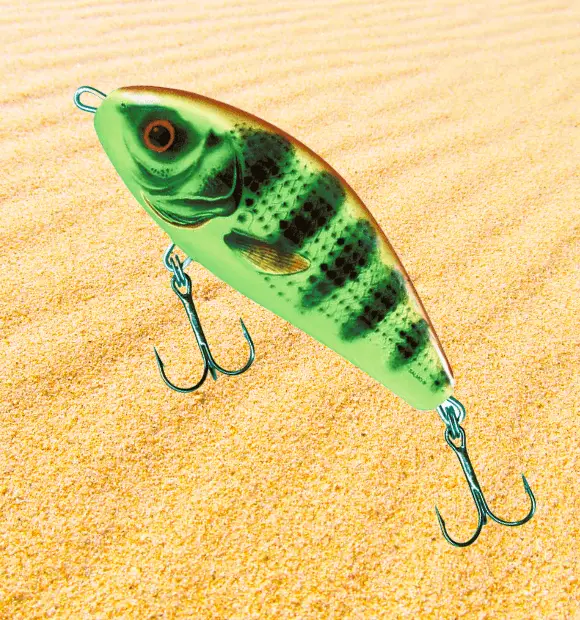
Walk-the-Dog
Another effective type of saltwater topwater lure is the walk-the-dog lure. When retrieved, this type of lure features a side-to-side swimming action, imitating a wounded baitfish struggling at the surface. The erratic movement and enticing splash created by walk-the-dog lures can entice even cautious fish to strike, making them a favorite among avid saltwater anglers.
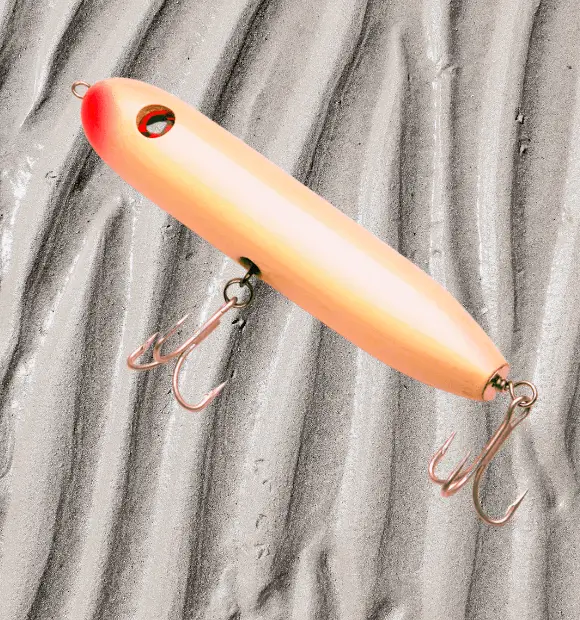
How to Use Saltwater Topwater Lures?
Saltwater topwater lures can be an exhilarating and effective way to target some of the most exciting saltwater game fish. Creating a lifelike action that mimics prey skittering across the water’s surface is essential when using these lures. One effective technique is the walk-the-dog retrieve, where you twitch your rod tip to make the lure zigzag back and forth. This mimics injured baitfish and can trigger explosive strikes from predatory fish like striped bass, tarpon, or redfish.
Another critical aspect of using saltwater topwater lures is choosing the right time to use them. Low light conditions, such as early morning or late evening, are prime times for topwater action, as predatory fish may be more willing to strike near the surface when visibility is limited.
Additionally, casting accuracy plays a crucial role when using these lures – placing your lure close to a structure or along current lines increases your chances of enticing a strike from lurking predators. By mastering these techniques and understanding when to use them, anglers can unlock the thrilling potential of saltwater topwater lures and have unforgettable experiences on the water.
Best Practices for Using Saltwater Topwater Lures
A few best practices can significantly enhance your fishing experience when using saltwater topwater lures. First and foremost, it’s essential to vary your retrieval speed and cadence. Saltwater fish are often attracted to erratic movements, so try mixing up fast and slow retrieves to trigger those aggressive strikes.
Additionally, consider the weather conditions – a gentle presentation may work best on calm days, while a more aggressive approach could be necessary in choppy waters.
In addition, please pay attention to the power of color choice when it comes to saltwater topwater lures. Bright colors like chartreuse or pink can be highly effective in muddy water or low-light conditions, while natural tones like white or silver may entice fish in clear water.
Lastly, always pay attention to the structure of your fishing area. Rocks, jetties, and submerged vegetation are prime spots for predatory species lurking beneath the surface, waiting for an easy meal.
These best practices for using these magical lures can take your fishing game to new heights. Mastering retrieval techniques, choosing the right colors for the conditions, and honing in on prime locations will increase your chances of landing your dream catch on every outing.

Pros and Cons
Pros
- Saltwater topwater lures can attract aggressive strikes from predatory fish, leading to exciting surface explosions.
- They allow anglers to target various species, including tarpon, snook, striped bass, and redfish.
- Topwater fishing provides visual excitement as anglers witness the action unfold right on the water’s surface.
- These lures create a thrilling challenge for anglers who enjoy mastering the art of topwater presentations.
- Using saltwater topwater lures often leads to memorable and visually stunning catches for great fishing stories.
Cons
- Topwater lures may not be as effective during certain weather conditions or when fish are not actively feeding near the surface.
- Working these lures requires skill and practice, which may result in missed strikes or frustration for less experienced anglers.
- Some saltwater species may be more hesitant to strike at topwater lures than other bait presentations.
- Topwater fishing can be physically demanding and exhausting due to continuous casting and reeling over extended periods.
- These lures may be more easily affected by wind and choppy water conditions, making precise presentations challenging.
Tips for Choosing the Right Saltwater Topwater Lure
Size and Weight
When choosing a suitable saltwater topwater lure, remember a few essential tips. Firstly, consider the size and weight of the lure to the target species you’re aiming for. More significantly, heavier lures are better suited for bigger game fish like tarpon or striped bass, while lighter lures may be more effective for species like sea trout or snook.
Pay Attention to the Action
Secondly, pay attention to the action of the lure. Different topwater lures have varying actions – some produce a loud popping sound, while others create a subtle splashing effect. Understanding the behavior of your target fish can help determine which type of action is most enticing to them.
Color and Design
Lastly, consider the color and design of the lure. Natural colors that resemble local baitfish can be highly effective in clear waters, while bright and bold colors may stand out in murkier waters or low-light conditions. Ultimately, experimentation is vital – don’t be afraid to try different types of lures and techniques until you find what works best for your specific fishing environment and target species.
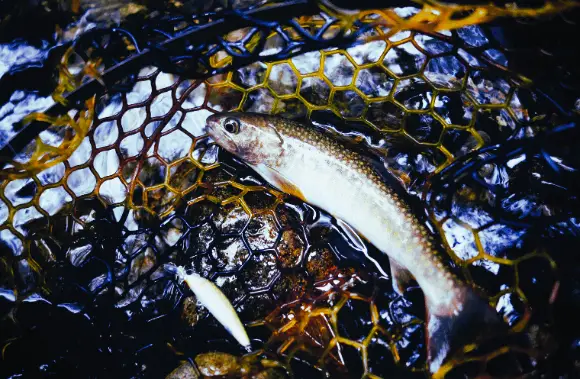
Conclusion
Saltwater topwater lures are valuable to any angler’s tackle box due to their versatility and effectiveness in various fishing environments. Whether targeting snook in the shallows or chasing tuna in deeper waters, these lures offer various applications. By experimenting with different retrieval techniques and adjusting your approach, you can effectively entice various fish species to strike.
Their ability to mimic natural prey and create enticing surface disturbances makes them an essential tool for any angler looking to maximize their catch potential. So next time you hit the water, pack your saltwater topwater lures and unleash their potential on your next fishing adventure!
FAQs
Q. How do I choose the right topwater lure for saltwater fishing?
A. Consider the size and color of the lure based on the target species and prevailing conditions.
Q. What are some effective retrieval techniques for saltwater topwater lures?
A. Vary your retrieval speed, incorporate pauses, and experiment with different movements to mimic natural prey.
Q. What types of saltwater game fish can be targeted using topwater lures?
A. Striped bass, redfish, snook, tarpon, and speckled trout respond well to topwater presentations.
Q. How important is it to understand the behavior of saltwater game fish when using topwater lures?
A. Understanding their feeding patterns and tendencies can improve your success in enticing strikes.
Q. Can weather conditions affect the effectiveness of saltwater topwater lures?
A. Wind, cloud cover, and water clarity can influence how fish respond to topwater presentations.


Leave a Reply